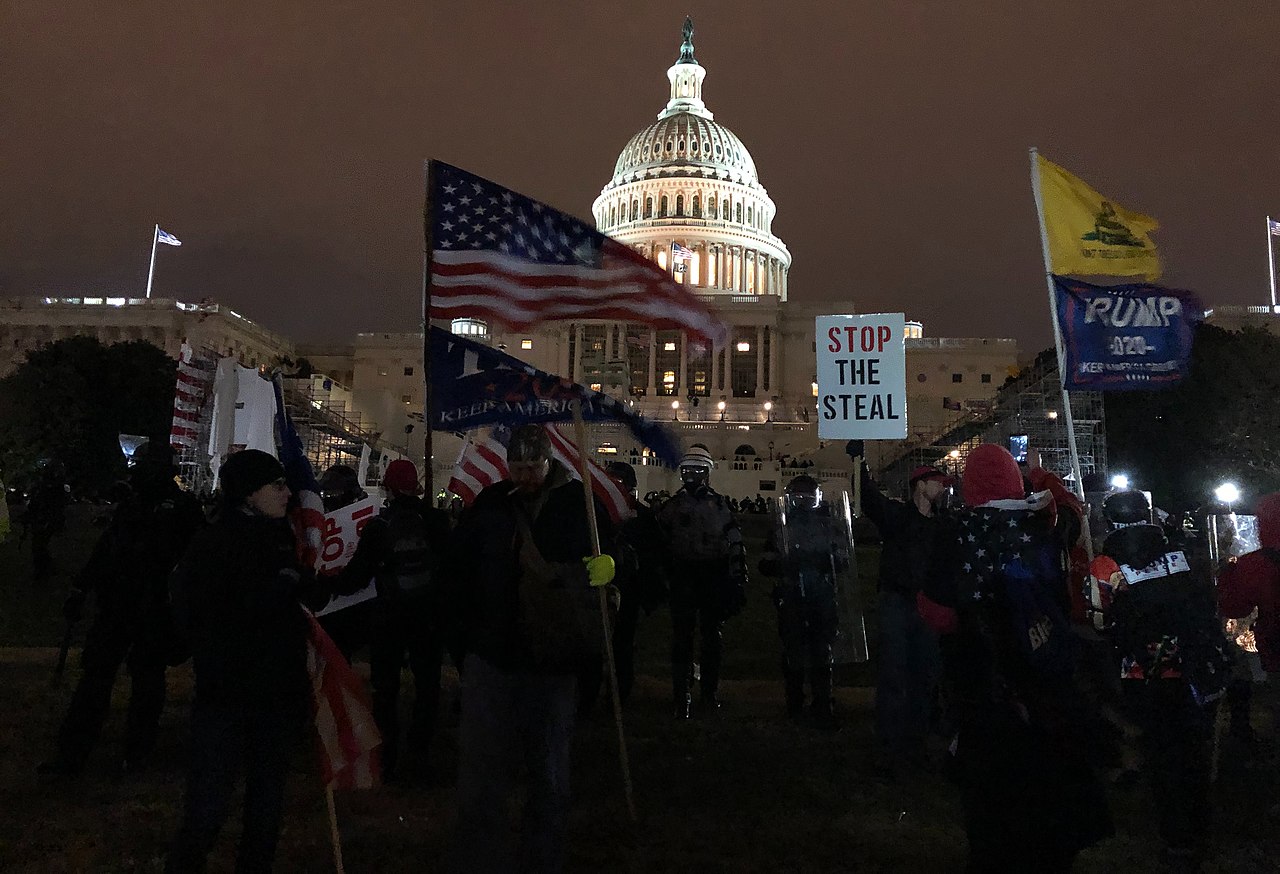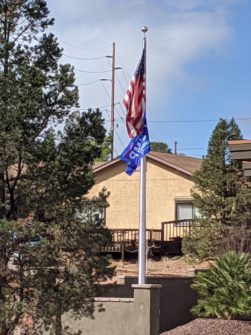
With the outbreak of Covid-19 in 2020 many involved in new age spirituality denied the reality of the pandemic entirely. They held this position in common with many on the political right-wing, particularly those labelled Christian nationalists. These groups may seem like strange bedfellows. New age spirituality involves understanding “the universe” as a form of divinity, composed of energy vibrating at certain frequencies, the raising of which has a millenarian outcome called the ascension, or in earlier parlance the coming “new age” of peace and harmony. It may seem genealogically connected with the 1960s counterculture, and so is often characterized as left-wing politically. How those involved in new age spirituality came to share common ground with Christian nationalism indicates conjoined roots in neoliberalism. A consideration of this convergence complicates our view of exactly what “religious nationalism” entails.
Instead of accepting the reality of the pandemic, those involved in new age spirituality blamed another environmental toxin like chemtrails, perhaps spread by 5G, which were designed for the purpose of forcing vaccinations and furthering government control. This denialism put many engaged in new age spirituality in line with the rapidly spreading QAnon theories, which they were exposed to through shared online ecosystems. Posts on social media combined hashtags for spiritual awakening and QAnon, indicating a cross-pollination between the two. One of my long-term interlocutors, a man I met because he slept in a tent in the backyard of the house where I studied meditation in Sedona, Arizona, began posting memes that indicated his shift toward Christian nationalism. This may seem surprising, but those involved in such spirituality are not, or are no longer, the left-wing hippies of caricature. What I first observed when I began my fieldwork in 2012 was a form of anti-politics. Many of those involved in new age spirituality rejected all political affiliations and did not want to be involved in politics at all as it was seen as lowering their “vibration.” By 2020, they had transformed into supporters of an imminent civil war because they felt under attack by mask and vaccine mandates.
As an anthropologist, I have been studying new age spirituality since 2012, completing multiple periods of ethnographic fieldwork in Sedona, a nucleus of the burgeoning spiritual scene in the US due to the presence of special energy locally known as “vortexes.” People involved in spirituality in Sedona would often report awakening experiences. It was a fundamentally disruptive experience that altered their life course, a key moment on their spiritual path that led them to become shamans, starseeds, or yoga teachers. They also expressed a fundamental disagreement with society as it is currently organized, with capitalism, environmental destruction, and political corruption as major complaints. There was also a prevalence of conspiracy theories concerning chemtrails, anti-vaxx, fluoride, UFOs, and deep underground military bases, or DUMBs. There was even a rumor in town that there was a DUMB underneath Secret Canyon. Political scientists and journalists often distinguish between “real” conspiracies, things that really happened, and “conspiracy theories,” things that are patently false and dangerous to democracy. But for my interlocutors, the existence of verifiable conspiracies indicated the truth of conspiracy theories; they were connected.
Conspirituality creates a space of convergence between new age spirituality and other religious traditions that may on the face of it seem to have disparate political commitments. Charlotte Ward and David Voas (2011) coined the term “conspirituality,” combining new age spirituality and conspiracy theory to describe this ostensibly surprising convergence. While conspiracy theories have long been a core part of new age spirituality, they are also becoming an increasing presence in contemporary American Christianity, especially among Christian nationalists, who express a conviction that God is on America’s side, Jesus died for their nation, and American prosperity is contingent on the Christian faith. Being against Christianity in any way is seen as being against America. This means that they think that their understanding of Christianity should be privileged in law and public policy, and if the government is not aligned with Christian nationalist ideology, it should be overthrown, which appears to be the justification of many of the rioters at the Capitol in Washington DC on January 6, 2021. In Taking America Back for God (2020), sociologists Andrew Whitehead and Samuel Perry link Christian nationalist commitments to support of a social order with a hierarchy based on gender, race, citizenship status, and sexuality. As the story goes, this social order is being undermined and Christian nationalists know it.
Much of the blame for the subversion of this social order is placed on “enemies,” both foreign and domestic. This is where conspiracy theories enter in as explanatory frameworks. Many of the conspiracy theories popular among Christian nationalists, like in new age spirituality, are animated by broadly populist sentiments—anti-government, anti-intellectual, anti-science, and anti-corporate (but pro-small business). The “elites” are doing something nefarious to the masses in an us vs. them situation. Conspiracy theories operate as explanations for events, occurrences that go against presumptions of the “natural” or “normal” order of things—9/11 must be an inside job because the great and mighty American empire cannot be undone by box cutters and amateur pilots; Obama must be a fraud because the president of America cannot be Black. In White Evangelical Racism, historian Anthea Butler recounts how conspiracy theories became more tolerated by evangelicals after the election of Obama, who they felt threatened their beliefs in a White nationalistic Christianity (130).
There are major differences between new age spirituality and Christian nationalism. For example, “America” as a nation is fetishized in the latter but rejected in the former. Spirituality is also more socially progressive than Christian nationalism. However, it is also fiscally conservative, even libertarian. Christian nationalists and those involved with new age spirituality hold prosperity in common as a value, the former via the prosperity gospel and that latter via prosperity consciousness, in which trusting the universe takes the place of trusting God’s plan as the route to riches. Prosperity for both is rooted in Whiteness, requiring an unacknowledged subjugation and exploitation of Blackness. Whiteness does not entail that these movements are composed entirely of White people, but rather that they are ideologies that uphold and promote what Butler calls a “cultural whiteness” (141). Another point in common is millenarianism. Both expect an imminent end of this world, with a new perfected world to be created in its place that is purged of impure elements. Both Christian nationalism and new age spirituality have adherents who have embraced QAnon, with those more influenced by Christianity seeing Trump as the messiah, and those more influenced by new age spirituality seeing him as a lightworker (a spiritually enlightened being working on Earth to help others achieve ascension). Both also face emic dismissal as perversions, as not being “true” Christianity or “real” spirituality.

In Neoliberalism’s Demons, Adam Kotsko theorizes that freedom is understood in a moral paradigm as an index of “blameworthiness” in which demonization is a “form of moral entrapment” (2018, 2) through which political systems rooted in Christian theology legitimate themselves. The current form of political theology is neoliberalism, which he calls “the paradigm in which the strategy of moral entrapment that I call demonization has been pushed to its uttermost limits. Neoliberalism makes demons of us all, confronting us with forced choices that serve to redirect the blame for social problems onto the ostensible poor decision making of individuals” (2–3). In Ripples of the Universe (2021), I describe how new age spirituality is connected to neoliberalism via a moral individualism wherein reality is entirely created by individual choice. This means that any poor choices, and the outcomes that follow from them, are entirely one’s own fault. Many who subscribe to this moral system find themselves trapped by circumstances that are beyond their control. Yet, they still label the problems that they face—e.g. health problems they can’t afford to treat, job losses they can’t rebound from—as the result of poor choices.
Conspiracy theories fill in this gap between assumption and reality. They operate as a theodicy; someone else is to blame, much like the devil is to blame for human sin and suffering. Health problems are from a “toxic environment” of chemtrails, fluoride, and vaccinations; economic problems are caused by a “dark cabal” in the government undermining the economy to force a “great reset” to socialism. Conspiracy theories flourish in systems of thought that have no place for systemic thinking, in which there are only individuals with agency, operating either for the good or the bad. So, when those who think this way experience misfortune, they find an external agent to blame, and devise elaborate conspiratorial connections rather than accept that collective, social problems exist.
The rejection of public health policies to mitigate Covid-19 and the January 6 insurrection are two instances that indicate the ongoing erosion of trust in social and political institutions. What is occurring is not simply a difference of opinion, but an epistemological crisis, wherein there is a wide scale breakdown of social consensus around what counts as true or false. Overt White supremacy is on the rise, but so also is covert White supremacy. The latter can be seen in the proliferation of conspiracy theories common to both new age spirituality and Christian nationalism. The likelihood of increased violent conflict as a result of these theories is high. Conspiracy theories have been a part of the worldview of every right-wing domestic terrorist incident in last 50 years (12). Over the same period, there has been a rise in stochastic terrorism, where leaders do not have to order violent action, but merely imply their desire for it. Here, violence results from individual actors who see themselves as responding to the words of leaders, rather than direct orders. The January 6 insurrectionists understood themselves to be at the Capitol in response to the words of former president Donald Trump, while he maintained a cloak of deniability that he was merely calling for peaceful protests.
Conspiracy theories motivate violence, and they are often spread by political actors in order to increase the likelihood of violence while simultaneously avoiding personal accountability. There was a political conspiracy behind January 6: a conspiracy to subvert the election of President Joe Biden by the former president Donald Trump and his allies. Conspiracy theories were spread to motivate people to take part in a violent riot to seize power by illegitimate means. “Real” political conspiracies and “conspiracy theories” work together in a dynamic that undermines democracy by exploiting people’s pre-existing beliefs, fears, ideals, values, and assumptions of a “natural” social order. A conspiracy theory explains something that transgresses those assumptions, something that therefore must be the work of an “evil” other. That other must be destroyed to restore the “natural” or “correct” social order. Because the stakes are so high, violence is justified from this point of view.

